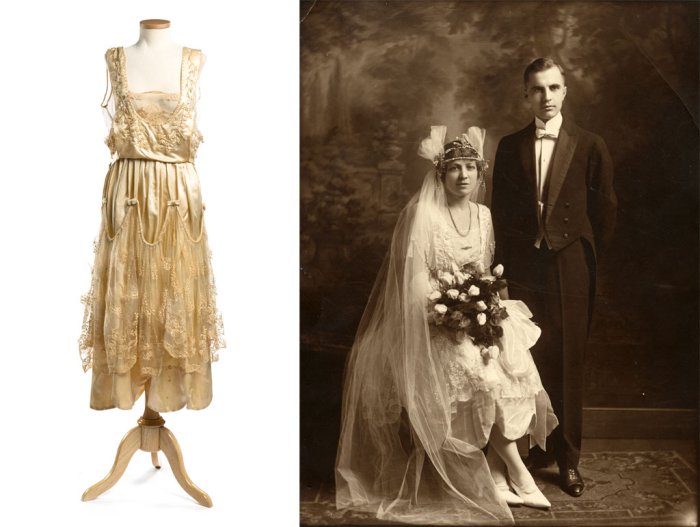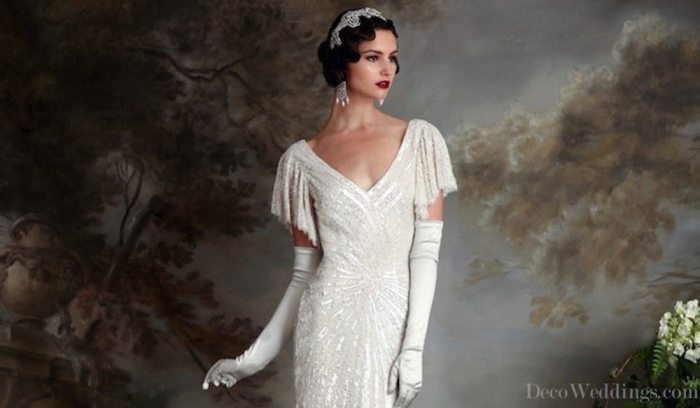Defining the “Real” 1920s Wedding Dress
Real 1920s wedding dress – The “real” 1920s wedding dress is characterized by a distinct silhouette and fabric choices, reflecting the era’s social and stylistic shifts. Understanding these defining features allows us to distinguish authentic gowns from later interpretations.
Silhouette and Fabrics of Authentic 1920s Wedding Gowns
The 1920s saw a dramatic departure from the corseted, full-skirted styles of previous decades. The defining silhouette was slim and straight, often featuring a dropped waistline that emphasized the hips. Common fabrics included lightweight materials like silk charmeuse, satin, crepe de chine, and georgette, allowing for the fluidity of the new, relaxed fit. Heavier fabrics like lace and velvet were sometimes used for embellishment or in colder months, but the overall effect remained one of elegance and streamlined simplicity.
Evolution of 1920s Wedding Dress Styles
While the dropped waist and straight silhouette were dominant, subtle changes occurred throughout the decade. The early 1920s saw more conservative styles, with longer hemlines gradually shortening as the decade progressed. The influence of the flapper style became increasingly apparent, with dresses featuring shorter hemlines, beaded embellishments, and a more youthful, playful aesthetic by the late 1920s.
Real 1920s wedding dresses often featured dropped waists and shimmering fabrics, reflecting the era’s elegance. While traditional ivory was popular, considerations for a modern twist might involve exploring less conventional palettes, such as the sophisticated combination showcased in this pink and gray wedding dress , which offers a fresh perspective on period-inspired designs. This could inspire reinterpretations of the classic 1920s silhouette using unexpected color choices.
Comparison of 1920s Wedding Dresses with Preceding and Succeeding Decades
Compared to the Victorian and Edwardian eras, 1920s wedding dresses were significantly less elaborate. They abandoned the restrictive corsetry and voluminous skirts in favor of a more relaxed, modern look. The contrast with the 1930s is less stark, with some overlap in the use of bias-cut fabrics and sleek silhouettes. However, the 1930s saw a return to more defined waists and fuller skirts, indicating a shift away from the distinctly straight lines of the 1920s.
Table Comparing Different 1920s Dress Styles
| Style Name | Description | Typical Fabrics | Notable Features |
|---|---|---|---|
| Dropped Waist | Empire-like waistline falling below the natural waist. | Silk charmeuse, satin, crepe de chine | Long, straight silhouette; often beaded or embroidered. |
| Beaded Gown | Heavily embellished with beads, sequins, or pearls. | Silk, chiffon, net | Intricate detailing; often Art Deco inspired patterns. |
| Flapper-Influenced | Shorter hemline, looser fit, often with fringe or embellishments. | Georgette, silk, lace | More youthful and playful style; often incorporated jazz-age influences. |
| Simple Silk Gown | Minimalist design emphasizing the quality of the fabric. | High-quality silk, satin | Clean lines, elegant simplicity; often paired with elaborate headpieces. |
Embellishments and Details of 1920s Wedding Dresses
The embellishments on 1920s wedding dresses were as significant as the silhouette itself, often reflecting the Art Deco aesthetic and the era’s fascination with geometric patterns and luxurious materials.
Common Embellishments and Their Significance
Beading was extremely popular, often in geometric or floral patterns. The type of beading—glass, pearl, or metallic—indicated the bride’s social standing and the gown’s overall cost. Lace, particularly Cluny and filet lace, was also frequently used, adding a touch of delicate elegance. Embroidery, often in Art Deco motifs, further enhanced the gowns’ visual appeal. The use of fringe, particularly on flapper-influenced dresses, added movement and a touch of playful modernity.
Symbolism of Decorative Elements
While not always overtly symbolic, the choice of embellishments could reflect the bride’s personality and aspirations. For instance, pearl beading might symbolize purity and elegance, while geometric patterns could reflect the era’s modern aesthetic. The use of specific floral motifs could hold personal meaning for the bride, reflecting family traditions or personal preferences.
Visual Representation of a Typical 1920s Wedding Dress, Real 1920s wedding dress
Imagine a gown of ivory silk charmeuse, cut in a straight, dropped-waist silhouette. The bodice is simply styled, with a modest V-neckline. Geometric patterns of clear and opalescent glass beads are delicately embroidered along the neckline and cascading down the skirt in a subtle, repeating motif. The skirt falls to just below the knee, allowing for a glimpse of the bride’s fashionable shoes.
A simple, yet elegant, headpiece of pearls and crystal accents completes the look.
The Social Context of 1920s Weddings
The social norms and customs of the 1920s significantly influenced wedding attire. Understanding this context provides a deeper appreciation for the choices brides made regarding their wedding dresses.
Social Norms and Customs Surrounding 1920s Weddings
Weddings in the 1920s, while still formal affairs, were becoming less rigidly structured than in previous decades. The rise of flapper culture and changing social roles for women led to a more relaxed and informal atmosphere in some circles. While large, formal receptions remained common among wealthier families, smaller, more intimate gatherings became more acceptable among the middle and working classes.
Influence of Social Context on Wedding Attire
The shift towards simpler, more streamlined dresses reflected the broader societal changes. The dropped waist and straight silhouette symbolized a move away from the restrictive norms of previous generations. The shorter hemlines of flapper-influenced dresses reflected the era’s embrace of modernity and a more youthful aesthetic.
Role of the Bride in 1920s vs. Modern Weddings
The bride in the 1920s, while still expected to adhere to certain social expectations, enjoyed a degree of autonomy in choosing her attire that was unprecedented in previous decades. While family influence remained significant, brides had more say in the overall style and formality of their weddings. This contrasts with modern weddings, where the bride often has greater creative freedom and a wider range of options for her dress and the overall celebration.
Societal Influences on 1920s Wedding Fashion
- Women’s suffrage: The achievement of women’s suffrage empowered women to make choices that reflected their newfound independence.
- Changing social roles: Women were increasingly entering the workforce and pursuing higher education, leading to a shift in social expectations.
- The rise of flapper culture: This rebellious youth culture promoted a more relaxed and informal style of dress.
- The Art Deco movement: This artistic style, with its geometric patterns and emphasis on elegance, significantly influenced the design of wedding gowns.
Modern Interpretations of 1920s Wedding Dresses

Source: charlestonmuseum.org
Contemporary designers continue to draw inspiration from the elegance and simplicity of 1920s wedding dresses, adapting the era’s key elements to create modern interpretations.
Contemporary Reinterpretations of 1920s Styles

Source: decoweddings.com
Modern designers often incorporate the dropped waistline, straight silhouette, and beaded embellishments of the 1920s into their designs. However, they may use modern fabrics and construction techniques to create a more comfortable and durable gown. They also adapt the original designs to suit contemporary tastes, incorporating modern necklines, sleeves, and back details.
Key Elements Frequently Incorporated into Modern Gowns
The most commonly adapted elements include the dropped waist, the straight silhouette, and beaded or sequined embellishments. The use of Art Deco-inspired patterns, lace details, and subtle fringe are also popular choices. Modern designers often retain the overall spirit of the 1920s style while updating it for contemporary sensibilities.
Comparison of Modern Fabrics and Techniques
Modern designers utilize a wider range of fabrics than were available in the 1920s. While silk charmeuse and satin remain popular choices, modern designers also use other luxurious fabrics such as silk crepe, mikado silk, and even modern lace blends. Modern construction techniques allow for greater comfort and durability, while maintaining the elegant drape of the original designs.
Example of a Modern 1920s-Inspired Gown
A modern designer might create a gown from ivory silk crepe, featuring a dropped waist and a slightly more relaxed A-line silhouette than the strictly straight gowns of the 1920s. Delicate Art Deco-inspired beading would adorn the neckline and shoulders, while a subtle train adds a touch of drama. The back might feature a keyhole opening and delicate lace detailing, reflecting modern trends while maintaining the overall spirit of the 1920s aesthetic.
Preservation and Authenticity of Vintage 1920s Wedding Dresses: Real 1920s Wedding Dress
Preserving a vintage 1920s wedding dress requires careful handling and specialized expertise. Understanding the challenges and proper techniques is crucial for maintaining its integrity and historical significance.
Challenges in Preserving Vintage Wedding Dresses
The age and fragility of vintage garments pose significant challenges. The fabrics can be brittle and prone to tearing, and the embellishments may be loose or damaged. Exposure to light, moisture, and pests can further degrade the condition of the dress. Improper handling and storage can accelerate deterioration.
Methods for Cleaning, Restoring, and Storing Vintage Garments
Cleaning and restoration should only be undertaken by experienced conservators specializing in vintage textiles. They use specialized techniques and materials to clean and repair the dress without causing further damage. Proper storage involves keeping the dress in a cool, dark, dry place, away from direct sunlight and pests. Acid-free tissue paper and archival-quality boxes are recommended for storage.
Reputable Resources for Authentication and Preservation
Museums, historical societies, and specialized textile conservators are valuable resources for authenticating and preserving vintage clothing. They can provide expertise in identifying the age and origin of the dress, as well as guidance on proper care and preservation techniques.
Step-by-Step Guide for Handling and Storing a Vintage 1920s Wedding Dress
- Handle the dress with clean, cotton gloves to avoid transferring oils and dirt.
- Avoid stretching or pulling on the fabric.
- Store the dress flat in an acid-free box, using acid-free tissue paper to support the fabric and prevent creasing.
- Keep the dress in a cool, dark, dry place, away from direct sunlight and moisture.
- Regularly inspect the dress for signs of damage and consult a conservator if needed.
Top FAQs
Where can I find authentic 1920s wedding dresses?
Authentic 1920s wedding dresses can be found at vintage clothing shops, online auction sites, and antique stores specializing in vintage clothing. However, careful authentication is crucial to avoid reproductions.
How much does a real 1920s wedding dress cost?
The cost of a real 1920s wedding dress varies greatly depending on its condition, fabric, embellishments, and provenance. Prices can range from a few hundred to tens of thousands of dollars.
How do I care for a vintage 1920s wedding dress?
Professional cleaning and preservation are highly recommended for vintage wedding dresses. Proper storage in an acid-free environment is essential to prevent damage.
